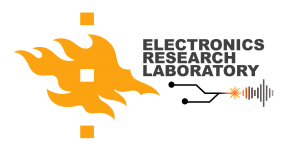Electronics II (MATR335). Spring 2022
Page updated 10.5.2022
Electronics II (MATR335), 5 ECTS, spring 2022
Lecturer: Prof. Edward Hæggström, edward.haeggstrom (at) helsinki.fi
Assistants: Henri Österberg – henri.osterberg@helsinki.fi
Julius Korsimaa – julius.korsimaa@helsinki.fi (Weekly reports and final project submissions)
Petri Lassila – petri.j.lassila@helsinki.fi (Exercises submission)
News
- No final project help -session on WED 4.5
- Remember to send your time usage logs to Julius every Friday before 16:00 (even if you have not done anything this week).
Final project
During the course you need to keep track of your time usage on the final project and send your time usage log weekly to Julius every Friday before 16:00 (even if you have not done anything this week).
Submit your log via email and put “Electronics 2 log week X, YOUR NAME” as the subject and send them to julius.korsimaa@helsinki.fi. The log should contain at least actions taken and time used. For example: “Discussed project plan, 2 hours”. Remember to send a log even if nothing of importance was done.
In the final project you are to create your own IoT (or other microcontroller based) design. The project consists of three parts: planning, demo and documentation.
The demos are to be presented at 13.5.2022 at 1200 o’clock in Physicum E204.
Instructions
Course info
Course grading: 50% of course grade comes from exercise points. There are ~6 points available in each of the 8 weekly exercises. The other 50% of the grade comes from the final project. The final project is divided into three parts: planning (25%), demo (50%) and documentation (25%). The course cannot be passed without presenting a working demo.
Duration: 3. and 4. period
Timing in studies: Advanced studies
Prerequisites: Electronics I, Measurement methods in Physics
Recommended: Basic programming skills
Course description: The aim of the course is to learn to use digital components and microprocessors as well as to learn the basics of the latest microelectronics opportunities offered for information technology and signal processing.
Scope: 10 credits
Literature:
– Tocci: Digital Systems, 12th ed (2017)
– Floyd: Digital Fundamentals, 11th ed (2015)
– Horowitz & Hill: The Art of Electronics, 3rd ed (2015)
The internet is also your good friend:
Arduino Language Reference – The documentation of the Arduino language
Arduino Registers control 1 // Arduino Register control 2 (alternative source)
Arduino Timer interrupts
Electronics Tutorials – Well written tutorials
Falstad circuit simulator – Capable electronics simulator with great visualizations
https://simulator.io/board/AWZpw7Fy3I/2 – Enlightening simulation of a CPU
Lectures
Exercises
Wed 14-16, Physicum D117 and Zoom
Week 0 (No submission): Install Arduino IDE, familiarize yourself with it and learn to add libraries. These skills will be needed in the coming exercises. Check the built-in examples and try to upload the blink program to Arduino (when you get yours).
Exercise 5 | Solutions 5
Exercise 6 | Solutions 6
Exercise 7 | Solutions 7
Exercise 8 | Solutions 8
About the kits:
Please store the components in their anti-static bags. This minimizes the chance of ESD damage. (Also don’t connect the motor directly to the Arduino board.)
The quality of the instructions there isn’t great so don’t depend your life on it. When using a component it’s strongly encouraged to skim through the datasheet. This way you will not only learn the specs of the component but you will also develop skills for reading datasheets in general.
Exercise submission
- Come to the exercise session and show a working setup or send us well documented code and picture/video of the setup by email if you cannot attend. Be mindful of the file sizes.
- The exercises should be returned as whole sets. If submitted via email put “Electronics 2 exercise week X, YOUR NAME” as the subject and send them to petri.j.lassila@helsinki.fi.
- The deadlines can be found on the exercises themselves.
- You will need access to a computer (preferably a laptop) and Arduino IDE (or equivalent) to complete the exercises.
